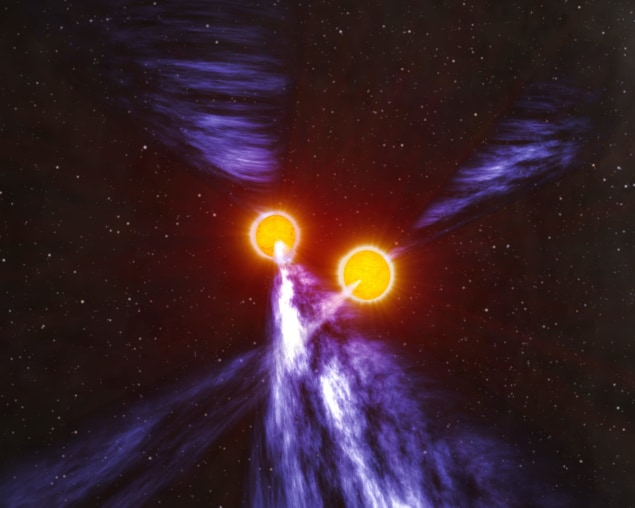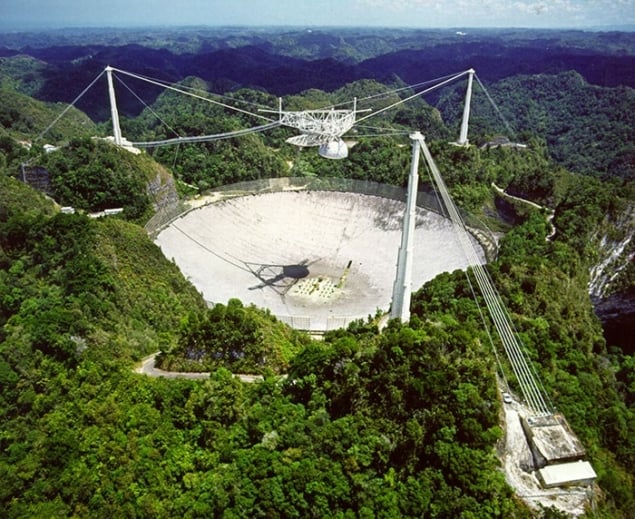In the run-up to the announcement of the 2021 Nobel Prize for Physics on 5 October, we’re running a series of blog posts looking at previous recipients and what they did after their Nobel prize-winning work. Margaret Harris examines the circumstances that shaped the career of 1993 laureate Russell Hulse

In the summer of 1974, Russell Hulse was down in the weeds of collecting data for his PhD thesis when he noticed something odd. Together with his supervisor Joseph Taylor, Hulse was using the famed 305 m spherical reflector dish at the Arecibo Observatory in Puerto Rico to search for pulsars: compact and highly magnetized stars that broadcast bursts of radio waves across the galaxy as they rotate. Although the first pulsar had been spotted only six years earlier by another student-and-supervisor pair, Jocelyn Bell Burnell and Antony Hewish, these unusual stars were already a hot topic in astrophysics. Hulse hoped to make his mark by identifying more of them, but one of the 40 pulsars in his data was causing problems. Denoted PSR 19 13 + 16 in his notebook, it defied all his efforts to calculate its period of rotation.

At the time, Hulse’s reaction was not “Eureka!” but instead, as he later recalled, “a rather annoyed ‘Nuts – what’s wrong now?’” Determined to get to the bottom of whatever technical glitch was causing the problem, Hulse focused his remaining observing time on this perplexing pulsar. By mid-September, he had his answer, and it was a doozy: PSR 19 13 + 16 was one half of a binary pair of stars, and its hard-to-calculate period was fluctuating under the gravitational influence of its companion.
For the next several months, Hulse worked as a self-described “pulsar data acquisition system” while Taylor performed orbit analysis calculations to test predictions of how this binary pulsar system should behave. Their findings were a stunning confirmation of Einstein’s general theory of relativity and, not incidentally, the first evidence of gravitational radiation. With these gold-plated results under his belt, the announcement that the 1974 Nobel Prize for Physics would honour the first pulsar discovery must have seemed, to Hulse, like a foretaste of the accolades that awaited him in his astronomy career.
By 1975, however, Hulse had a dilemma. Although he obtained a postdoctoral appointment at the National Radio Astronomy Observatory (NRAO) in Charlottesville, Virginia, soon after finishing his PhD, it wasn’t a permanent job. “While I still enjoyed doing pulsar radio astronomy, from the moment I arrived at NRAO I was increasingly preoccupied with the lack of long-term career prospects in astronomy,” he later recalled. “While I had some confidence that I could find another position of some sort after NRAO, it was not at all clear to me when, where, and how I would be able to settle down with some reasonable expectation of stability in my career.” His concerns were sharpened by his personal circumstances. With his then-girlfriend (later wife) Jeanne Kuhlman doing graduate work in physics at the University of Pennsylvania and soon to embark on her own career, Hulse decided that “the potential for such repeated major dislocations in my personal life was more than I could quite tolerate”.

When his NRAO appointment ended in 1977, therefore, Hulse left astronomy to take up a post at the Princeton Plasma Physics Laboratory (PPPL), located conveniently close to Jeanne in Philadelphia. He was able to switch fields in part because he did his PhD in physics rather than astronomy – a choice that reflected both his broad scientific interests and his desire to hedge his career bets – and in part because pulsar-hunting was already, in the mid-1970s, a highly computerized task. (In a lecture I attended in the early 2000s, Hulse joked that he spent so much time programming at Arecibo that he took to adding up his chequebook in hexadecimal.) At PPPL, his first task was to create new computer codes to model the behaviour of impurities in high-temperature plasmas. By 1993, when he and Taylor won the Nobel Prize for their binary pulsar discovery, he had carved out a niche as a developer and maintainer of codes for modelling thermonuclear fusion.
At this point, it is instructive to reflect on the Nobel committee’s differing treatment of Hulse and Bell Burnell. While Hulse and Taylor shared the 1993 prize equally, the pulsar half of the 1974 prize went solely to Bell Burnell’s supervisor Hewish (another astronomer, Martin Ryle, received the other half for unrelated work). While sexism surely played a role in this snub, Bell Burnell has long attributed it to her lowly student status; in 1974, she says, the Nobel committee had not yet realized that PhD students could and did make significant intellectual contributions. In this light, it is worth noting that in his Nobel lecture, Hulse paid tribute to Taylor for treating him and other students as “colleagues rather than subordinates”. Hence, the divergent Nobel fates of Hulse and Bell Burnell may be down to differing supervisory styles, as well as discrimination and shifting attitudes towards PhD students.
It is hard not to see Hulse’s career path as an indictment of how early-career research is funded and organized
In his official 1993 Nobel biography, Hulse comes across as sanguine about his career. “My interest in science has never been so much a matter of pursuing a career per se, but rather an expression of my personal fascination with knowing ‘how the world works,’” he wrote. Like other scientists who received the Nobel at a relatively young age (he was 42), Hulse found that the prize brought invitations to serve on advisory boards in academia, government and industry. In 2004, he accepted a visiting professorship at the University of Texas at Dallas with a focus on science education, and he remains on the faculty there, though the scope of his activities has been limited since 2012, when he was diagnosed with Parkinson’s disease. His wife Jeanne, for her part, retired in 2020 from a long career in the pharmaceutical industry.

Migration and the Nobel prize: more than one quarter of physics laureates are immigrants
Despite these achievements, though, it is hard not to see Hulse’s career path as an indictment of how early-career research is funded and organized. Forty-four years after a lack of job security forced this future Nobel laureate out of radio astronomy, academic career prospects remain highly uncertain. Researchers who are disinclined to change jobs (and sometimes countries or continents) every few years as postdocs still find their path to permanent positions blocked. And the same “two-body problem” that confronted Hulse and Kuhlman nearly half a century ago continues to force difficult choices onto scientific couples today, with consequences that affect all genders but disproportionately damage the careers of women. The Nobel committee’s attitude towards PhD students may well have changed since the mid-1970s. Too many other things have not.
Physics World‘s Nobel prize coverage is supported by Oxford Instruments Nanoscience, a leading supplier of research tools for the development of quantum technologies, advanced materials and nanoscale devices. Visit nanoscience.oxinst.com to find out more.




